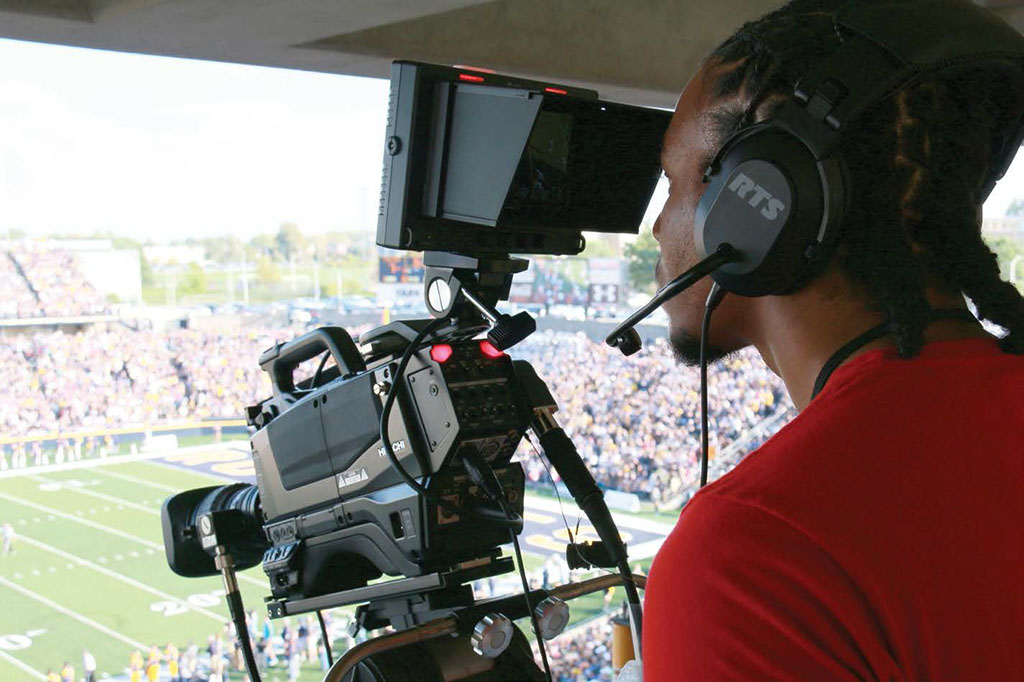Hitachi HDTV Cameras Enhance Stadium, Mobile Sports Production for University of Toledo
TOLEDO, OHIO—The University of Toledo Rockets compete across 15 NCAA Division I sports in the Mid-American Conference. Our live sports production class in the Department of Communication provides students with hands-on, credit-earning learning experiences while serving the video production needs of the university’s Athletics department.

We rely on Hitachi HDTV cameras to provide high-quality image acquisition for both stadium-based and mobile productions. Our most recent additions are four Z-HD6000 studio and field production cameras for our football stadium, the “Glass Bowl.” The stadium previously used very old standard-definition cameras from multiple manufacturers that required an unsustainable amount of maintenance. When it came time to replace them and upgrade to HD, our satisfaction with Hitachi Z-HD5000 cameras on our mobile production truck led us to again turn to Hitachi Kokusai.
VENUE COVERAGE
The Z-HD6000 cameras provide video for in-house productions that are shown on the stadium’s 40-foot wide video board and TVs throughout the venue. Three of the cameras are stationed on tripods, while the fourth is operated handheld on the sidelines. All four are connected via fiber to CU-HD500 base stations in the control room over cable runs of more than 1000 feet each, with MultiDyne SMPTE-HUT transceivers converting between SMPTE fiber and tactical fiber for transport over the stadium’s existing single-mode fiber infrastructure.
Between football seasons, the stadium’s handheld Z-HD6000 is also used as a fifth camera on our production truck, complementing four Hitachi Z-HD5000s permanently assigned to the vehicle. The truck’s cameras are used in varying fixed-position and handheld combinations depending on the particular sport or event being covered, including soccer, basketball, volleyball, baseball, softball, swimming, and non-athletic activities such as concerts and commencements.
I like the Hitachi cameras because they’re reliable, produce great images, and they’re very competitively priced. In my experience, to buy a camera in the same class from another major manufacturer, you’re looking at a lot more money to get something that does the same thing.
I really like the way the Hitachi cameras look right out of the box; the color, saturation and contrast all look great. That superb quality really stands out when we produce ESPN3 streaming broadcasts in our basketball arena, where cameras from a different manufacturer are used for the video board. Iso feeds from our Hitachi cameras are seen side-by-side in the control room with shots from the other vendor’s cameras. It takes a lot of adjustments on the other cameras to get them to look nearly as good as the Hitachi units, and the other cameras still don’t quite get there.
TAKES A LICKIN’
The durability of the Hitachi cameras is similarly impressive. They are primarily used by students who have varying levels of competency and experience when they begin the program. The ZHD6000s and Z-HD5000s handle abuse very well, and have also withstood some pretty severe conditions. At one soccer match, we had 60 mph winds that actually blew a camera over. The tripod and shotgun microphone didn’t survive, but the camera kept working.
Beyond the technical attributes of the Hitachi cameras and the positive impact on our production quality, they also deliver valuable educational benefits, exposing students to broadcast-quality equipment at a price we can afford. As a department, we not only focus on helping students successfully complete the program, we also focus on getting them jobs. It’s experiential learning that gets students to that point, and the Hitachi cameras help us do that. Our students are able to say they’ve shot eight different types of sports in live productions, with equipment that’s comparable or better than what they will be using in their first jobs.
For me, another big advantage is customer service. There are a lot of good products out there, but Hitachi Kokusai has been awesome in terms of taking care of us and going above and beyond. We love the Hitachi cameras and have had great experience with them over the years, and we love the support we get from the company.
John Eidemiller is executive producer, ESPN3 & Athletic Video Productions in the Department of Communication at the University of Toledo. He can be reached atjohn.eidemiller@utoledo.edu.
For more information on Hitachi Kokusai Electric America, visitwww.hitachikokusai.usor call 855-891-5179.
Get the TV Tech Newsletter
The professional video industry's #1 source for news, trends and product and tech information. Sign up below.
